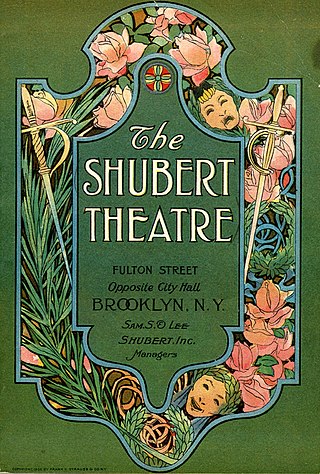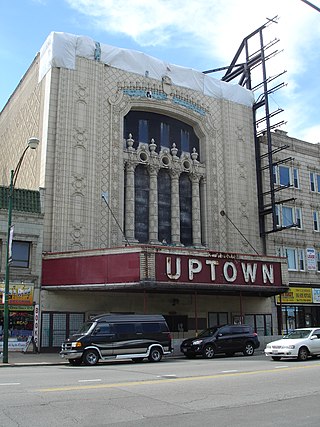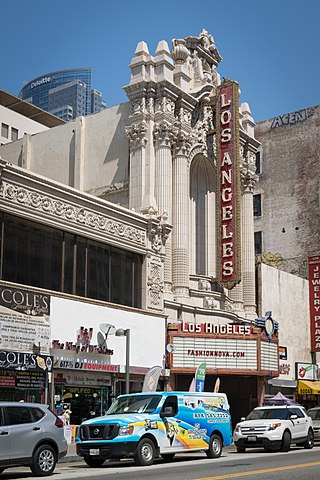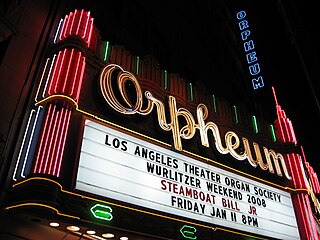
The Shubert Organization is a theatrical producing organization and a major owner of theatres based in Manhattan, New York City. It was founded by the three Shubert brothers in the late 19th century. They steadily expanded, owning many theaters in New York and across the United States. Since then it has gone through changes of ownership, but it is still a major theater chain.
Mayfair is a district in the City of Westminster in London, England.

A movie palace is any of the large, elaborately decorated movie theaters built between the 1910s and the 1940s. The late 1920s saw the peak of the movie palace, with hundreds opening every year between 1925 and 1930. With the advent of television, movie attendance dropped, while the rising popularity of large multiplex chains in the 1980s and 1990s signaled the obsolescence of single-screen theaters. Many movie palaces were razed or converted into multiple-screen venues or performing arts centers, though some have undergone restoration and reopened to the public as historic buildings.

The Palace Theatre is a Broadway theater at 1564 Broadway, facing Times Square, in the Midtown Manhattan neighborhood of New York City. Designed by Milwaukee architects Kirchhoff & Rose, the theater was funded by Martin Beck and opened in 1913. From its opening to about 1929, the Palace was considered among vaudeville performers as the flagship of Benjamin Franklin Keith and Edward Franklin Albee II's organization. The theater had 1,743 seats across three levels as of 2018.

The Kings Theatre, formerly Loew's Kings Theatre, is a live performance venue in the Flatbush neighborhood of Brooklyn, New York City. Opened by Loew's Theatres as a movie palace in 1929 and closed in 1977, the theater sat empty for decades until a complete renovation was initiated in 2010. The theater reopened to the public on January 23, 2015 as a performing arts venue. It was listed on the National Register of Historic Places on August 22, 2012.

Milt Larsen was an American actor, writer, performer, lyricist, magician, businessman, speaker, and the creator of The Magic Castle, a private club for magicians and enthusiasts.

Broadway, until 1890 Fort Street, is a thoroughfare in Los Angeles County, California, United States. The portion of Broadway from 3rd to 9th streets, in the Historic Core of Downtown Los Angeles, was the city's main commercial street from the 1910s until World War II, and is the location of the Broadway Theater and Commercial District, the first and largest historic theater district listed on the National Register of Historic Places (NRHP). With twelve movie palaces located along a six-block stretch of Broadway, it is the only large concentration of movie palaces left in the United States.
Beatrice Kay was an American singer, vaudevillian, music hall performer, and stage and film actress.
Janet Adair was an American vaudeville, ragtime, musical revue and musical comedy performer in the early twentieth century, who also appeared in five movies.

The Los Angeles Theatre is a 2,000-seat historic movie palace at 615 S. Broadway in the historic Broadway Theater District in Downtown Los Angeles.

An atmospheric theatre is a type of movie palace design which was popular in the late 1920s. Atmospheric theatres were designed and decorated to evoke the feeling of a particular time and place for patrons, through the use of projectors, architectural elements and ornamentation that evoked a sense of being outdoors. This was intended to make the patron a more active participant in the setting.

The Robert Morton Organ Company was an American producer of theater pipe organs and church organs, located in Van Nuys, California. Robert Morton was the number two volume producer of theatre organs, building approximately half as many organs as the industry leader Wurlitzer. The name Robert Morton was derived not from any person in the company, but rather from the name of company president Harold J. Werner's son, Robert Morton Werner.

The Broadway Theater District in the Historic Core of Downtown Los Angeles is the first and largest historic theater district listed on the National Register of Historic Places (NRHP). With twelve movie palaces located along a six-block stretch of Broadway, it is the only large concentration of movie palaces left in the United States. The same six-block stretch of Broadway, and an adjacent section of Seventh Street, was also the city's retail hub for the first half of the twentieth century, lined with large and small department stores and specialty stores.

The Majestic Theatre is a performing arts theater in the City Center District of Downtown Dallas. It is the last remnant of Theater Row, the city's historic entertainment center on Elm Street, and is a contributing property in the Harwood Street Historic District. The structure is a Dallas Landmark and is listed on the National Register of Historic Places.

The Majestic Theatre is a 600-capacity live music venue in downtown Madison, Wisconsin. Opened in 1906, it is Madison's oldest theater, changing ownership many times and adapting to the many changes in the entertainment business throughout its history. Beginning as a vaudeville theater, it became a movie house by 1912 with occasional live acts, and converted to talking motion pictures by 1930. Today the theater is owned and operated by Matt Gerding and Scott Leslie who acquired the theater in 2007 and made it into a successful music club hosting DJs and live shows several nights a week.

The Orpheum Circuit was a chain of vaudeville and movie theaters. It was founded in 1886, and operated through 1927 when it was merged into the Keith-Albee-Orpheum corporation, ultimately becoming part of the Radio-Keith-Orpheum (RKO) corporation.

At the advent of the 20th century, the city of Portland, Oregon, was among the first on the United States West Coast to embrace the advent of the silent and feature film. The city's first movie palace, the Majestic Theatre, opened in 1911. By 1916, Portland had "the finest array" of movie houses on the West Coast relative to its population, pioneering venues dedicated exclusively to screening films. The popularization of the sound film in the early 1920s resulted in another boom of new cinemas being constructed, including the Laurelhurst, the Hollywood Theatre, and the Bagdad Theatre, the latter of which was financed by Universal Pictures in 1926.

Sony Hall is a concert venue operated by Blue Note Entertainment Group located on West 46th Street in the Theater District, Manhattan, New York City. Like many theaters in NYC, it has served many functions since its opening in 1938. Located in the basement of the Paramount Hotel, it began as Billy Rose's Diamond Horseshoe nightclub where the 1945 film Diamond Horseshoe was filmed, and later spent time as a burlesque theater before becoming a legitimate Broadway theatre under the names Century Theatre, Mayfair Theatre, and Stairway Theatre. As a Broadway theater, it is most well known for the transfer of the Tony Award-winning original Broadway production of On Golden Pond in 1979. After becoming a private venue through the 1980s and remaining mostly closed through the 1990s and 2000s, it reemerged in 2013 after a 20-million-dollar renovation as a theater hosting the immersive production Queen of the Night. It is currently run as a live music performance venue showcasing audio and visual technology by Sony.
Mayfair Theatre may refer to:
June Winters was an American actress and singer who was actively performing from the mid-1930s into the 1960s. She first came to prominence starring in the Broadway musical Hellzapoppin at the Winter Garden Theatre from 1938 through 1941. A versatile performer, her career spanned a wide array of genres from vaudeville to musicals to opera and popular music. Married to trumpeter and songwriter Hugo Peretti, she achieved her greatest success creating content for children as the "Lady in Blue" in partnership with her husband; releasing dozens of albums with sung and spoken material from 1947 into the early 1960s. The character Lady in Blue also had her own comic strip and Saturday morning radio program on NBC Radio. The couple also co-founded the Mayfair Records company.
















